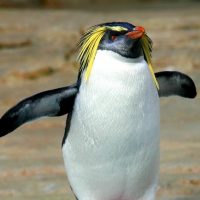Chinstrap penguin
CHINSTRAP PENGUINS
Scientific name: Pygoscelis Antarcticus.
Height: 27–30 inches (68–76 centimeters).
Weight: 7.1–11.7 pounds (3.2–5.3 kilograms).
Average lifespan in the wild: 15–20 years.
IUCN Red List status: Least concern, population decreasing (2020).
Range
CHINSTRAP PENGUINS
Chinstrap penguins prefer to form colonies on rocky surfaces, most commonly on subantarctic islands. They also nest further south on small islands off the Antarctic Peninsula, such as the South Shetland Islands, and have been spotted as far north as New Zealand.
The largest chinstrap penguin colony is on Zavodovski Island in the South Sandwich Islands, with approximately two million chinstraps breeding on its volcanic slopes.
Identification
CHINSTRAP PENGUINS
Chinstrap penguins are a member of the brush-tailed penguin family, and are closely related to Adélie and gentoo penguins.
Like most seabirds, they have black backs and white chests, which makes it more difficult for marine predators to see them in the water.
Their key identifying feature is the distinctive black line under their chin, which earns them their name.
Feeding
CHINSTRAP PENGUINS
Chinstrap penguins feed mostly on Antarctic krill, supplemented by a small amount of fish and squid.
They generally prefer to forage in relatively shallow water near their colonies or amongst the pack ice. However, when sharing a nesting site with gentoo penguins they tend to forage further offshore, particularly overnight. They can also be seen on rare occasions in the open sea. They are fast swimmers, traveling at speeds of up to 18 miles per hour (30 kilometers per hour).
While they can dive as deep as 230 feet (70 meters), most of their foraging dives are less than 147 feet (45 meters) deep and last less than a minute.
Life cycle
CHINSTRAP PENGUINS
Chinstrap penguins spend the winter feeding at sea, returning to their colonies in the spring.
Male chinstrap penguins arrive about five days before females. They generally return to their nesting site from the previous year, rebuilding their nests with stones and bones.
Females lay two eggs around the beginning of December – the exact timing varies depending on how far south they are. Both parents take turns incubating the eggs in six day shifts, and the eggs hatch after around 37 days.
Hatchlings are dependent on their parents for warmth, food and shelter, and remain in the nest for up to a month.
Life cycle
CHINSTRAP PENGUINS
After around 28 days chicks leave the security of the nest, finding protection in groups called creches. Creches provide warmth and safety in numbers, and chicks defend themselves and one another against predators. Parents continue to return to the colony to feed their chicks for another month or so.
Between 50 and 60 days after they hatch, the chicks’ downy feathers are replaced with waterproof, adult plumage, and they are ready to learn to swim and hunt for themselves.
As winter approaches, parents return to the colony to molt, replacing their worn feathers with new, waterproof ones for the season ahead.
Predators
CHINSTRAP PENGUINS
The primary predators at sea are orca (killer whales) and leopard seals. The penguins have distinctive black and white plumage, which provides a form of camouflage against the sea or sky called countershading. This offers some protection from marine predators. They also porpoise while swimming, breaking through the surface of the water much like dolphins. This motion may be used to build up speed or confuse predators.
On land, unattended eggs, chicks, and injured or sick adults are vulnerable to predation from southern giant petrels, skuas, and snowy sheathbills.
Adult penguins defend their chicks ferociously from aerial attacks, vocalizing and slapping predators with their rigid flippers to deter them.
Over the past 50 years, several chinstrap penguin colonies on the subantarctic South Shetland Islands have declined dramatically.
Protecting chinstrap penguins
ANTARCTIC PENGUINS
Chinstrap PENGUINS
Related reading
Now that you’ve learned about chinstrap penguins, read on to discover more about extraordinary Antarctica.
 ASOC
ASOC














